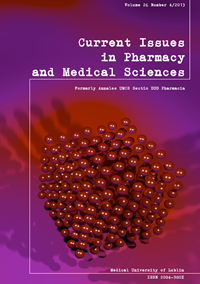Adult patients treated at the Department of Jaw Orthopaedics, Medical University of Lublin
DOI:
https://doi.org/10.12923/j.2084-980X/26.4/a.12Keywords:
orthodontic treatment, adult patients, malocclusionAbstract
The aim of the present study was to make an overview of the age, sex and malocclusion of adult patients admitted to the Department of Jaw Orthopaedics, Medical University of Lublin in the years 1995-2009.
In the 15 years under study, the orthodontic treatment was started by 8892 patients, including 642 patients above 18 years of age, which constituted 7.2% of the total number of patients treated during that period. The most numerous group was the group of 20-24 year-old subjects, whereas the least numerous was that including 35 year-olds. Women undertook orthodontic treatment decidedly more often - 69.8% of patients. In the years 1995-2009 adults from the Lublin region made up a small percentage of orthodontic patients treated in the Department of Jaw Orthopaedics (only 7.22%). Young adults (average age 22.9 years) prevail in the group of adult patients who decided on treatment. Women decide to start orthodontic treatment more frequently than men (69.8%). The main reason why both men and women decided on orthodontic treatment was dental abnormalities (52.5%).
References
1. Birkeland K., Bøe O., Wisth P. J.: Subjective assessment of dental and psychosocial effects of orthodontic treatment. J. Ortofac. Orthop., 58: 44-61, 1997.
2. Borysewicz-Lewicka M. et al.: Występowanie wad zgryzu u dzieci i młodzieży w wieku 12 i 18 lat województwa poznańskiego. Pozn. Stomat., 129-35, 1995-1996.
3. Burgermodijk R. et al.: Malocclusion and orthodontic treatment need of 15-74 year old Duth adults. Community Dentistry and Oral Epidemiology, 19: 64-7, 79, 1991.
4. Buttke T. M., Proffit W. R.: Referring adult patients for orthodontic treatment. J. Am. Dent. Assoc., 130: 73-9, 1999.
5. Cardaropoli D.: Orthodontics for the adult periodontal patient: first or second choice treatment? Prog. Orthod., 10: 88-96, 2009.
6. Celikoglu M., Akpinar S., Yavuz I.: The pattern of malocclusion in a sample of orthodontic patients from Turkey. Med. Oral Patol. Oral Cir. Bucal., 15:e 791-6, 2010.
7. Ericson S., Kurol J.: Radiographic examination of ectopically erupting maxillary canines. Am. J. Orthod. Dentofac. Orthop., 91: 483-92, 1987.
8. Golusik K. et al.: Zaburzenia zgryzowo zębowe populacji średniowiecznej i współczesnej Dolnego Śląska. Dent. Med. Prob., 42:465-71, 2005.
9. Gottlieb E. L., Nelson A. H., Vogels D. S.: 1990 JCO study of orthodontic diagnosis and treatment procedures I results and trends. J. Clin. Orthod., 25: 145-56, 1991.
10. Gottlieb E. L., Nelson A. H., Vogels D. S.: 1996 JCO study of orthognathic diagnosis and treatment procedures: Part I –results and trends. J. Clin. Orthod., 30: 615-29, 1996.
11. Grubb J. E. et al.: Radiographic and periodontal requirements of the AMERICAN Bard of Orthodontics: A modification in the case display requirements for adult and periodontally involved adolescent and preadolescent patients. Am. J. Orthod. Dentofac. Orthop., 134: 3-4, 2008.
12. Hassan A. H., Amin H.: Association of orthodontic treatment needs and oral health-related quality of life in young adults. Am. J. Orthod. Dentofac. Orthop., 137: 42-7, 2010.
13. Kawala B, Szumielewicz M, Kozanecka A. Are Orthodontists Still Needed? Epidemiology of Malocclusion Among Polish Children and Teenagers in Last 15 Years. Dent. Med. Prob., 46:273-78, 2009.
14. Khan R. S., Horocks E. N.: A study of adult orthodontic patients and their treatment. Brit. J. Orthod., 18: 183-94, 1991.
15. Onyeaso C.O, Aderinokun G.A, Arowojolu M.O, The pattern of malocclusion among orthodontic patients seen in Dental Centre, University College Hospital, Ibadan, Nigeria. Afr J Med Sci., 31:207-11, 2002.
16. Simmons H. C., Oxford D. E., Hill M. D.: The prevalence of skeletal class II patients found in a Consecutive population presenting for TMD treatment compared to the national average. J. Tennesse Dental. Association; 88: 16-8.
17. De Souza L.A. et al.: Prevalence of malocclusion in the 13-20-year-old categories of football athletes. Braz. Oral Res., 25: 19-22, 2011.
18. Suszczewicz A, Lisiecka K. Stan zgryzu populacji 12- i 18-latków w Polsce w 1995 roku. Przegl. Stomat. Wieku Rozw., 35/36:20-23, 2001.
19. Syryńska M. et al.: Epidemiologia zatrzymanego kła górnego w materiale Zakładu Ortodoncji PAM w latach 1994-2006. Forum Ortod., 3: 52-9, 2007.
20. Thilander B.: Infrabony pockets and reduced alveoral bone high In relation to orthodontic therapy. Semin. Orthod., 2: 55-61, 1996.
21. Varela M., Garcia-Camba J. E.: Impact of orthodontics on the psychologic profile of adult patients: A prospective study. Am. J. Dentofac. Orthop., 108: 142-8, 1995.
Downloads
Published
Issue
Section
License
Copyright (c) 2013 Authors

This work is licensed under a Creative Commons Attribution-NonCommercial-NoDerivatives 3.0 Unported License.


